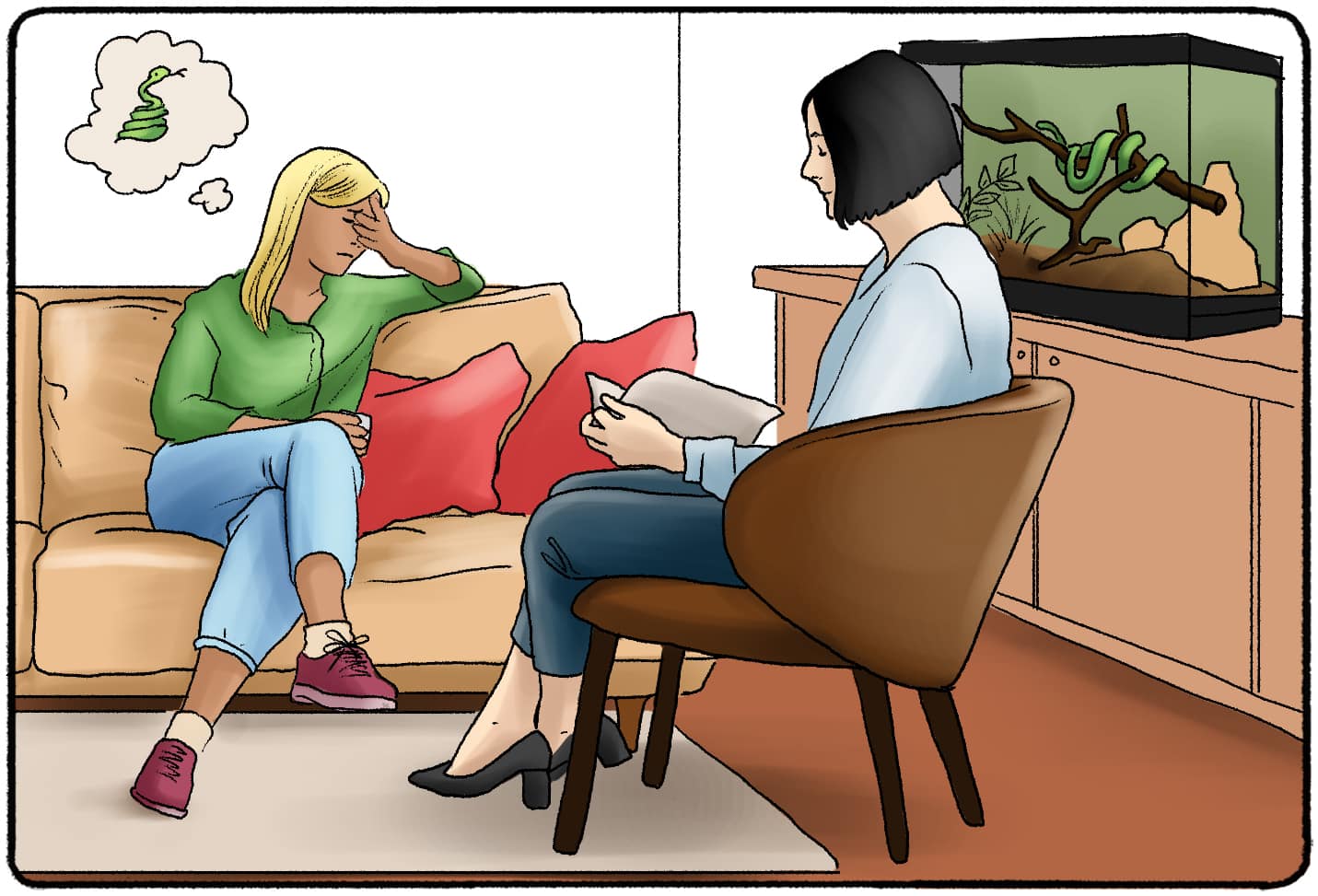Think about your worst fear. Maybe it’s spiders. Or heights. Or public speaking. Maybe this fear doesn’t interfere with your ability to do your job well or live a normal life. If it does, it may be considered a “phobia.” This is a word used to describe extreme or irrational fears. Often, these fears interfere with a person’s ability to go about their day as normal.
So what do you do?
There are many approaches to overcoming phobias. Some people use therapy. Other people use psychedelic drugs. Other people just try to avoid their phobia altogether. Throughout this page, I’m going to talk about one of the more extreme approaches. It’s called flooding therapy, and it involves a deep dive into the things that scare you the most.
(You can also explore other types of therapy and treatments for phobias just by clicking around this website!)
What Is Flooding Therapy?
Flooding therapy is just one type of exposure therapy used by professionals to help patients confront their fears. During any type of exposure therapy, the patient is exposed to the thing that scares them the most. Someone with a fear of snakes may be shown pictures of snakes.
Another example of flooding therapy is a “mock funeral”: a person with a fear of death may attend a mock funeral for themselves as a form of exposure therapy. A mock funeral and a picture of a snake are clearly on two different ends of the spectrum. Exposure therapy may involve more or less extreme versions of exposure, depending on the type of therapy being used and the condition of the patient.

Flooding therapy exposes the patient to their phobia, in all its glory, for a 2-3 hour session. This is one of the most extreme versions of exposure therapy.
Examples of Flooding Therapy
The session will vary depending on the patient’s phobia. Some examples of flooding therapy include:
- Placing someone with claustrophobia in a crowded room for two hours
- Putting someone with a fear of planes on a plane for a three-hour trip
- Leaving someone with a fear of snakes in a room with a snake (and telling the person they have to pet it)
How Does Flooding Therapy Help Patients?
For someone with a phobia, this can sound like a nightmare. But to someone who doesn’t have that fear, any of the above tasks don’t sound too awful. None of the scenarios are life-threatening (if a professional snake handler is nearby!)

Previously, the stimuli (the snake, flight, etc.) was associated in the patient’s mind with fear and overwhelming emotions. Flooding therapy offers an alternative. Now, the patient is exposed to the stimuli and new associations can be made. Over a long stretch of time, the patient’s mind will start to replace the old associations with new ones. The next time the patient is confronted with their former fear, they no longer associate it with bad memories or scary emotions.
How Long Does Flooding Therapy Take?
Patients may be exposed during a 2-3 hour session. At some point, the patient will become exhausted. They don’t have the energy to be anxious anymore, and progress will begin. But the number of sessions required for a patient to recover will vary.
You may have a reason for overcoming a phobia. Your best friend is getting married, for example, and you want to give a speech at their wedding despite your fear of public speaking. In these cases, you may have a goal and timeline for your treatment. Otherwise, do not worry about timing. Do not set yourself up to "fail" by saying that you will be completely cured in a single session or over the course of a few weeks. Look at each session as progress forward. Whether you take two steps or a giant leap, you're still making great progress.
How Therapists Use Flooding Therapy to Treat Mental Disorders
Flooding therapy is not just beneficial for people with phobias. A professional can use flooding therapy to treat or manage a range of disorders, including:
- Anxiety
- PTSD
- OCD
The process may look slightly different depending on the person’s condition and how they are affected by the disorder. For example, a person with PTSD may be asked to imagine the experience that resulted in the PTSD. Of course, this is done in the presence of a trained therapist.
(When a patient is simply asked to think of the phobia, the therapy may be called “implosion therapy.”)
A patient with OCD may be exposed to stimuli that “trigger” certain behaviors. They are asked to sit with those stimuli without performing those behaviors.
Patients don’t have to have a serious condition to benefit from flooding therapy and other methods of exposure therapy. A confrontation may make a patient anxious, but it isn’t a full-blown phobia. The therapist may use role-play and other forms of exposure to “mock” confrontation until the patient is comfortable confronting someone on their own.
Flooding Therapy Pros and Cons
Pros of Flooding Therapy
There are many reasons why a therapist would choose flooding therapy over other types of exposure therapy.
For one, there is only one session involved with flooding therapy. Methods like systematic desensitization or graded exposure require multiple sessions of the patient “warming up” to their phobia. (One session may be looking at a snake. The next session will be looking at a snake and visualizing seeing a snake. The patient eventually works their way up to being in the same room with a snake or petting it.) Flooding therapy is considered time- (and cost-) effective for many.

Think of exposure therapy as pulling off a Band-Aid. Flooding therapy is like pulling the whole bandage off in one motion. Other types of exposure therapy may only rip pieces of the Band-Aid off over a longer period of time.
Cons of Flooding Therapy
If flooding therapy sounds too intense, you’re not alone. While some therapists have found it to be an effective way of treating phobias or other conditions, other therapists prefer more gradual methods.
The shock of exposing someone with a serious phobia to that phobia may result in trauma or hospitalization. This doesn’t happen in every case, but it is a risk to consider if you and a mental health professional are considering flooding therapy as a treatment method.
Alternatives to Flooding Therapy
Flooding therapy is just one of many approaches to treatment for PTSD, anxiety, and phobias. Some approaches are more subtle, take place over a longer period of time, or shine traumatic experiences in a different light. If you are searching for a treatment plan for certain symptoms, be sure to ask local therapists about these approaches. Not all therapists use all approaches. Your local therapists may find some of these approaches to be ineffective. The best way to get effective treatments is to have these conversations and be intentional with the therapist you choose.
E.D.M.R.
Eye movement desensitization and reprocessing therapy, or E.D.M.R., is a type of therapy that helps people process traumatic memories. Like flooding therapy, the E.D.M.R. process might look bizarre to onlookers. Therapists ask patients to recall certain memories as the patient takes in other types of stimulation. The therapist may ask the patient to follow the therapist’s finger with their eyes as the memory is recalled or look at certain images.
The goal behind E.D.M.R. is to stimulate the brain in different ways while the memory is replayed. So often, people replay terrible memories in their minds and let the memories harm their mental wellness. E.D.M.R. takes a more active approach. And people have really found success with it! Since E.D.M.R. was introduced to the world in 1987, celebrities like Prince Harry and Evan Rachel Wood have found healing through E.D.M.R. sessions. (Typically, patients go through 8-12 E.D.M.R. sessions that last between 60-90 minutes.)
Narrative Exposure Therapy
What if you could see your phobias like the villain in the book? A dragon to be slayed? This is the idea behind narrative exposure therapy. The approach asks patients to lay out the events in their life as though they were a narrative. By seeing their lives and traumatic experiences through a narrative arc, the patient may gain a new perspective or even see how far they’ve come.
This approach is used to treat people who have been through many different types of complex trauma, but it is still a relatively new approach.
CBT
What if our mental health symptoms didn’t come from the events we experienced, but from how we talked to ourselves about those events? This is a question that CBT can help you explore. Cognitive behavioral therapy, or CBT, is a popular form of talk therapy. Therapists use information from their clients to assign “homework” and discover different coping methods that result in a healthy, happy lifestyle. If you are experiencing depression or have phobias, CBT can help you alter your thinking patterns and see the world in a brighter, safer light.
Group Therapy
Talking about your fears to a group of people may be scary, but it might be the trick to overcoming phobias! Group therapy is exactly what it sounds like. Groups meet together to discuss their fears, thoughts, anxiety, etc. Often, these groups are approached using the principles of CBT. Therapists may offer group therapy as an addition to individual therapy or exclusively allow patients to attend group therapy sessions.
Existential Therapy
What do phobias mean? What does it mean to have phobias and overcome them? How do phobias play into the biggest questions in life and humanity? You can explore these questions in existential therapy. This type of therapy focuses on the big topics: life, death, existence, etc. It is a form of psychotherapy, which was formerly used to treat many phobias and symptoms of mental illness. If talking about the here and now doesn’t seem to work, talking about much deeper topics may be able to help!
Reach Out to a Licensed Professional
How do you know which type of therapy is right for you? Explore! If you are looking to treat a phobia or mental condition, continue to do research. Weigh the pros and cons of other methods. Be sure to reach out to a licensed professional as you do your research. Most therapists or counselors will offer a free consultation before booking a session. In this consultation, you can discuss which approaches they use and your goals for therapy. Not all therapists will be a match. That's okay. Continue to look, and don't be afraid to try out a few sessions first.
A working therapist may be able to point you in the right direction and give suggestions for treatments or professionals that may work best for your condition and situation. You do not have to live with phobias. Whether you use flooding therapy or another means, you can get help and live a happy life.



